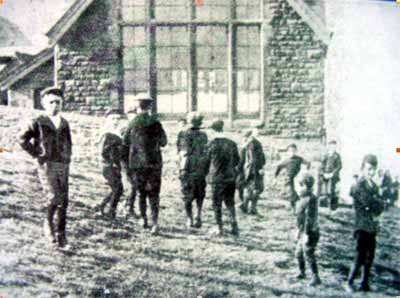
On September 5, 1911, in Llanelli, Wales, the children’s revolt began in Bigyn School, where in protest at a teacher’s punishment the students left the playground and paraded the streets, visiting other schools and calling on the pupils to join them. New Dock, Lakefield and Old Road Schools came out in solidarity.
The key confrontation of Britain’s first national railway strike – for better pay and an end to an unfair arbitration system – occurred on August 19, 1911, in Llanelli, a tinplate-producing town in south west Wales. The Llanelli strike was brutally suppressed by police and troops of the Worcester Regiment.
The strike was highly politically sensitive, as the Great Western Railway through southwestern Wales was the main route between England and Ireland. The strike was part of one of the longest waves of sustained industrial rebellion in British working class history – the “Great Unrest” of 1910 to 1914.
During August and September of 1911 there were strikes by schoolchildren in at least 62 towns and cities, showing the huge impact the rail strike had within working-class communities. Their significance doesn’t relate to numbers – but the fact that young people, albeit a minority, felt empowered enough to speak out on issues that concerned them.
In 1912 the Amalgamated Society of Railway Servants, the General Railway Workers’ Union and the United Signalmen and Pointsmen combined to form the National Union of Railwaymen, a trade union of railway workers, not including clerks and salaried staff.
In the U.S., labor organizer Mother Jones “led a march of miners’ children through the streets of Charleston, W.Va., to illustrate the effects of poverty,” Sept. 21, 1912, amidst the fierce Paint Creek-Cabin Creek 1912-13 coal miners’ strike in that state. Jones had organized a “Children’s Crusade” nine years earlier in 1903, marching from Philadelphia, Pa. to President Theodore Roosevelt’s home in New York demanding child labor laws.
Just last month, Joelle Fishman reported: “It was thrilling to be part of the local organizing for the 50th Anniversary March on Washington and to travel with a bus full of young people age 7 on up looking for hope and eager to act. Once at the march, they collected over 200 signatures on petitions for the Youth Jobs Act introduced by Rep. John Conyers and Sen. Bernie Sanders.”
BBC Radio provides this list ofr further reading on the 1911 students’ strike:
The origins and significance of the school strikes in south Wales, 1911, R. Grigg, The Local Historian, vol.33 no.3 (August 2003).
When the Kids were united, D. Partridge, BBC History Magazine, September 2003, pp.24-26.
Protest by Pupils, R. Adams, (Falmer Press, 1991)
Hooligans or Rebels?, S. Humphries (Oxford, 1981)
Photo: Children’s strike at Bigyn school, 1911.










